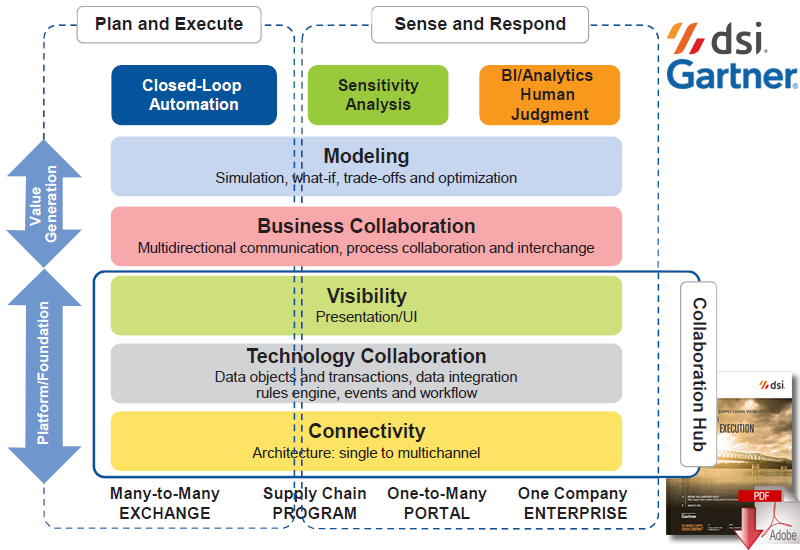With a theme like “The Art of Supply Chain: Creative Solutions for the Next Generation,” it’s no surprise that innovative problem-solving remained a prevalent theme throughout the presentations and discussions at this year’s Gartner Supply Chain Executive Conference.
Attendees not only focused on addressing current supply chain challenges, but also looked at what’s ahead - no crystal ball required. After all, the future of the supply chain is clear: digital business.
What Is Digital Business?
According to Gartner, “Digital business is the creation of new business designs by blurring the digital and physical worlds. It promises to usher in an unprecedented convergence of people, business and things that disrupts existing business models - even those born of the Internet and e-business eras.”
It can be easy to confuse digital business with earlier forms of business transformation, such as e-business. Digital business goes beyond e-business - doing business online - and digital marketing to bring together people, business and things in a way that fundamentally transforms how businesses operate, seize competitive advantage and produce value.
At DSI, they are already helping customers evolve their digital business strategy - for example, using connected sensors to monitor performance on equipment like airplane tires, something that not only maximizes employee time by eliminating unnecessary maintenance checks but also ensures optimal use of assets and a better customer experience.
“[Digital business] is about the interaction and negotiations between business and things,” writes Gartner, Inc.’s Jorge Lopez for Forbes. “It is when things start to negotiate amongst themselves as well as people and business that we start to see how we have entered an entirely new and disruptive world. In the past, people were a proxy for things in business. In the future, things will be an agent for themselves and will thus shift the way a business views its opportunities.”
Digital business represents an exciting mix of challenges and opportunities throughout the supply chain. To help you prepare for this new era of doing business, we’ve highlighted four critical elements discussed at the Gartner Supply Chain Executive Conference that are necessary for your digital business.
Four Ways Your Digital Business Will Thrive
1. Bimodal: Agile, Yet Rock Solid
There’s a reason that bimodal business was highlighted in the conference’s first keynote by Peter Sondergaard, Head of Research, Gartner, Inc. Consider this perspective from Sondergaard: “If you haven’t started building bimodal, you’re behind.”
Bimodal, as its name implies, is the creation and application of two concurrent business models that bridge the gap between your current operations and what your business will be in the future. Mode 1 is viewed as the more traditional operations and processes - shared supply networks, for example, or tools like an enterprise system of record. This is the mode on which your business was built and runs - it’s traditional, reliable, predictable and safe.
Mode 2 is where you hit the gas. This is where agility, innovation and speed thrive, giving you an opportunity to grow, experiment and fail. Yes, we mentioned the f-word - and giving your business room to fail is a huge part of success. As Sondergaard pointed out in his keynote, 70% of transformational projects fail, but those that don’t can have an enormous impact on changing your business.
2. Collaboration: We’re in This Together
We’ve talked before about the importance of collaboration when creating and implementing a mobile business strategy - and when you’re talking about anything technology-related, even when it is a supply chain strategy, you can’t underestimate the importance of IT’s involvement.
Collaboration Layers

Source: Gartner (2013)
Cisco’s John Kern talked about effectively partnering with IT to be an enabler in the digital business world, giving you the technological and operational knowledge to capture optimal value. In fact, Kern recommends building foundational business architecture that unites applications and all other supply chain support functions with IT.
Once you have that architecture in place, you have the solid foundation on which to create the new business models that are such an imperative part of digital business. And, as Frank Crespo, CPO of Global Supply Network for Caterpillar, Inc., says, you can engineer your supply chain as a value chain through which information flows as seamlessly as materials. That introduces another level of collaboration: giving supply chain stakeholders like suppliers and planners the visibility that empowers them to be successful and anticipate problems before they happen, key elements to digital business success.
3. Put Your Data To Work
When you do digital business, you create connections that result in a huge, previously untapped set of data that includes everything from equipment performance analytics and environmental conditions to customer buying behavior and product lifecycle statistics.
The trick, of course, is to actually use and analyze this data to drive operational enhancements and business decisions. It’s also key to recognize that data is about more than a current view, although real-time visibility is critical to preserving brand and product integrity, not to mention maintaining efficient supply chain performance. Data (and its subsequent analysis) is also an important part of future planning, which enables true synchronization of supply and demand and the creation of lean, efficient operations with the agility and fluidity to successfully adjust to rapidly changing circumstances.
4. Take Risks, Embrace What’s Possible
One of the more memorable highlights from the Gartner Supply Chain Executive Conference? Guy Kawasaki’s gem, “Don’t worry, be crappy.” When we discussed bimodal business earlier in the post, we talked about creating a second business layer in which you not only have innovation and speed, but also room to fail forward and learn. This mindset likely goes against the nature of many supply chain executives, but when you’re doing business in such a fast-paced and rapidly changing marketplace, you can’t afford not to learn those important lessons that come with doing.
“Most companies don’t create the next curve because they define their business based on what they already do,” Kawasaki says. It’s not a bad thing to know your company’s sweet spot and the core products or services you provide. Yet what can you do to innovate as a digital business? How can your product or service be improved? What new product or service can you create? What problems will your customers have that you can help solve? You know that old saying, “If at first you don’t succeed, try again.” Make that a priority. Keep trying, keep creating and keep looking ahead - and if you fail, don’t let it stop you.
With the creativity and innovation required by digital business, supply chain management truly has become an art. The time is now to plan your company’s Mobile Supply Chain masterpiece.
What will you make possible with your supply chain?
Related: Leveraging a Mobile Platform for Automated Data Collection and Beyond

Article topics
Email Sign Up

















